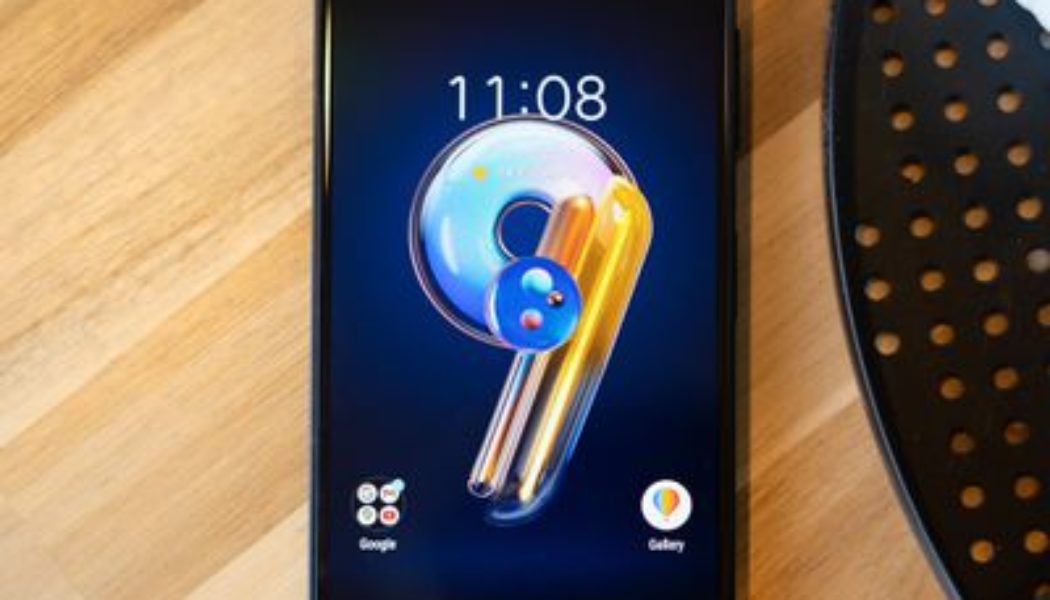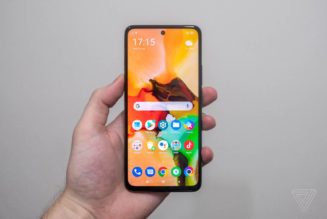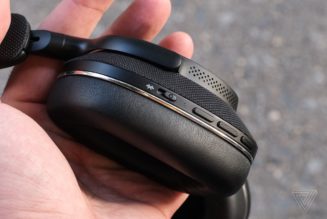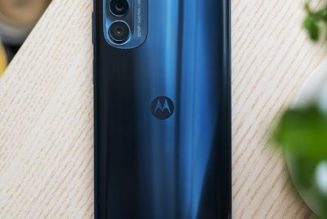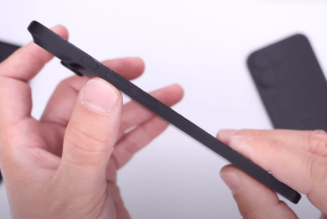Unboxing the Asus Zenfone 9 was like meeting someone new and learning that you like the same obscure movies or went to the same high school. I could tell immediately we’d get along. “You’re IP68 and you have a headphone jack? No way! I love headphone jacks!”
A lot of the attraction has to do with its size. As it did with the Zenfone 8, Asus has set out to answer the question “what would a small (read: reasonably sized) flagship Android phone look like?” The answer starts with a 5.9-inch screen — not nearly as small as the 5.4-incher on the iPhone Mini. But as far as the Android ecosystem goes, it’s downright tiny.
“Small and runs Android” isn’t the only thing going for the Zenfone 9: it offers top-shelf components like a Snapdragon 8 Plus Gen 1 processor, a smooth-scrolling 120Hz display refresh rate, and a 12-megapixel main camera with a one-of-a-kind stabilization system. It starts with 8GB of RAM and 128GB of storage for $799 and will go on sale in the US directly from Asus in mid-September. Introductory pricing will be lower — $699 — and you can find global versions of the phone on Amazon right now for a bit less than MSRP. However, there’s good reason to wait until it’s officially on sale: Asus provides a one-year warranty with the phone when you purchase it directly, and the imported versions floating around now don’t include that.
For more information on our scoring, see How We Rate.
Even when you’re riding high because you met your new best friend, you have to come back down to reality eventually. The Zenfone 9 isn’t the perfect small phone: it lacks wireless charging, which most phones at this price include. There’s also no telephoto camera, which isn’t a given in a phone under $1,000, but the (also $799) Samsung S22 does include one. The Zenfone 9 doesn’t work with every US carrier, either. It functions on AT&T and T-Mobile’s networks, but you’re out of luck on Verizon. Trust me, I tried.
Then there’s software support. Asus is committing to two platform OS updates and a paltry two years of security patches. A phone at this price point should really get more years of software support. This makes it hard to broadly recommend the Zenfone 9, especially with the very good, five-years-of-security-updates, works-on-every-carrier Galaxy S22 in the same price bracket. But like certain genres of cult classic movies, it will really hit the spot for a specific kind of person, and I’m one of them.
The Zenfone 9 embraces 2022’s return to flat rails rather than the era of rounded edges that the iPhone 6 ushered in. This exterior frame is aluminum, and the display curves ever so slightly where it meets the sides. The front panel is glass, but the back is a composite polymer material with a textured, soft finish that makes the phone easy to grip one-handed. The whole thing feels sturdy, and it’s rated IP68 for robust water and dust resistance.
:no_upscale()/cdn.vox-cdn.com/uploads/chorus_asset/file/23904877/zenfone_9__2.jpg)
Did I mention it’s small? It is, and I love it. There’s an assortment of high-end phones on my desk as I write this, and they’re all very capable. But when I hold the Zenfone 9, it just feels like a sigh of relief. It takes up so little space that when I put it in the pocket of my yoga pants, I’ll keep doing that thing where I think “oh crap, I left my phone in the house” and then discover with relief that it is actually in my pocket. This is not something that happens when I’m carrying a 6.4-incher like the Google Pixel 6 in my pocket. The only phone more comfortable to carry in my pocket literally folds in half, so well done, Asus.
The power button on the side of the phone does triple duty as a fingerprint sensor and a “Smart Key.” The latter offers a customizable interaction when you swipe your finger across the button from top to bottom. By default it’s set to pull down the quick settings and notification shade; it’s a nice way to check notifications one-handed without having to reach up to the top of the screen, which is still a stretch, even on a phone this small.
The feature works well. Too well. Whenever I was using the phone with two hands, my right palm kept accidentally pulling the shade down. This was annoying, and I turned the Smart Key feature off. On the bright side, I appreciate that Asus doesn’t make you remember a button combination when you want to turn off the phone — you just long-press the power button like in the good old days.
The 5.9-inch OLED on the Zenfone 9 offers a top refresh rate of 120Hz, which is more or less standard in the flagship class now. It makes for a smooth scrolling experience, and the flagship-grade Snapdragon 8 Plus Gen 1 processor paired with 8GB of RAM makes the phone feel plenty responsive for everyday and even heavy tasks. The screen’s peak brightness of 1,100 nits means it can be comfortably used even in very bright conditions. It’s a relatively small phone, so it’s probably not how you want to watch a whole season of television, but the built-in stereo speakers are surprisingly good if you do use it to watch video. You can even hear something like bass coming from them! And there’s more good audio news: the Zenfone 9 still has a headphone jack. A headphone jack! That’s just thoughtful. It all checks out as top-tier hardware.
The software is lovely, too. It’s a light touch on Android 12 that stays out of your way. When it does request my attention, it’s very polite, like with pop-up text in the camera app recommending that I shoot in brighter conditions or that I turn on battery saving if I want to use the gimbal stabilization for a long time. Otherwise, it’s a heck of a lot like using a Pixel phone. But one thing that’s not Pixel-like is the support. Asus is committing to two OS platform upgrades and only promises two years of security updates. For the same $799 price, the Galaxy S22 comes with a promise of four OS version updates and five years of security patches. The Zenfone 9 just isn’t a great option if you plan to keep your phone longer than a couple of years.
It’s not entirely clear whether the Zenfone 9 will support 5G in the US, either, even though it has the right hardware. As of this writing, Asus spokesperson Ester Suh told us that 5G on AT&T was “in progress.” I checked with T-Mobile, and its official stance is that it hasn’t certified the device — the Zenfone 9 supports the right bands, but T-Mobile considers it a “bring your own device” situation and says it can’t guarantee performance. I haven’t been able to test it myself, and in any case, it’s a good idea to check with your carrier whenever you buy an unlocked phone whether it will work on its 4G and 5G networks.
Battery life is usually high on the list of small phone problems; they tend to have smaller batteries that struggle to deliver a full day’s worth of usage. The Zenfone 9 doesn’t; its combination of a 4,300mAh battery and the power-efficient 8 Plus Gen 1 processor gets it through a day of moderate use (clocking around two hours of screen-on time with the always-on display enabled constantly) without a problem. By default, the phone operates on a “Dynamic” mode for battery optimization. You can opt for “High performance mode,” which Asus describes as the “best choice for demanding apps.” There are two modes below dynamic that conserve more battery life, but I found the default mode provided a good balance of performance and battery stamina.
There’s good news and bad news on the battery charging front. The bad news, as mentioned above, is that there’s no wireless charging. It’s more or less a given on high-end phones these days, so it’s a shame that the Zenfone 9 doesn’t include it. It’s hard to imagine that this is a tradeoff to keep the phone size down since the smaller iPhone 13 Mini includes it. In any case, the good news is that the Zenfone 9 supports fast 30W charging and even includes the 30W charging brick in the box. That’s especially useful if you do push the Zenfone 9 with a lot of battery-intensive tasks like streaming video and gaming — upward of four or five hours of screen-on time. In that case, its relatively small battery would benefit from a late-afternoon boost to make it through the end of the day.
:no_upscale()/cdn.vox-cdn.com/uploads/chorus_asset/file/23904893/zenfone_9__3.jpg)
Asus didn’t festoon the Zenfone 9 with useless depth sensors and macro cameras, and for that, I am grateful. There’s just one 50-megapixel standard wide camera with some serious stabilization (more on that in a second) and a 12-megapixel f/2.2 ultrawide with autofocus so it can double as a macro, plus a 12-megapixel selfie camera. There’s no telephoto lens, which kind of stinks. Image quality is good, generally speaking, though the Zenfone 9 sometimes gets into trouble with some aggressive over-sharpening. It’s not disastrous but not my favorite.
The main rear camera includes what can best be described as “gimbal stabilization.” It’s not just a lens element moving, and it’s not just the sensor, so “optical” or “sensor-shift” stabilization aren’t the right terms. Virtually every other flagship phone includes either optical or sensor-shift stabilization.

On the Zenfone 9, everything moves together — lens and sensor — to compensate for camera shake, which is more robust than the typical methods. Asus says it can better compensate for bigger movements than a traditional, optical-only system: up to three degrees of motion on six axes — vertical, horizontal, and back and forth — versus one degree. It’s coupled with electronic image stabilization, too, which smooths out motion even further and adds a “predictive” element thanks to Asus’ algorithms.
It’s seriously impressive. For starters, if you look closely, you can actually see the camera and lens moving around under the main housing when you turn on video mode. That’s wild. More importantly, it works really well. It’s most beneficial for video recording. With stabilization off, footage recorded while walking down a gravel path is a shaky, jumbled mess, just like you’d expect. Turning it on transforms the movement to a barely perceptible swaying. You’d usually need an actual gimbal mount, like the DJI OM 5, to get footage this steady, and the Zenfone 9 just does it all in-camera. That is very cool.
It’s not quite a killer feature, though. I’m not a fan of the color processing applied to my video clips — it looks over-brightened and too flat all at once. There’s also an intense crop if you use both electronic and gimbal stabilization that makes it very difficult to film anything in close quarters. Gimbal stabilization is also only available for 1080p HD clips, not in the 4K or 8K (lol) recording modes.
The benefits for still photos aren’t as significant. Better stabilization should make it possible to use slower shutter speeds in low light and still get sharp photos of static subjects. This seems to be the case, but that only makes it about as good as the Pixel 6 and its combination of OIS and computational tricks. It’s also not going to do anything for moving subjects. You’re still at the mercy of, you know, how light works.
Anyway, it’s cool, and I’m dying to take it out on a hike to record some video of the journey up to the top of a summit. With the IP68 rating, I wouldn’t even have to worry about the dust on the trail or how much sweat it’ll be exposed to in my yoga pants pocket. As much as I love taking pictures with the Galaxy Z Flip 4, that’s one environment I don’t feel great about exposing it to, and the Zenfone 9 would really excel there.
:no_upscale()/cdn.vox-cdn.com/uploads/chorus_asset/file/23971787/zenfone_9__4.jpg)
If you’re on AT&T or T-Mobile and you want a truly compact Android phone with flagship-grade performance, this is the one to seriously consider — provided you’re comfortable with the unfortunately short software support lifespan. It’s just lovely to use. I don’t miss the glass panel on the back one bit because the soft texture of whatever composite plastic that Asus has used is so lovely. It has camera capabilities that make me want to leave my house and shoot video. To be clear, my house is where the (softest) soft pants and espresso machine are. This is a serious barrier to overcome.
That pleasantness extends to the experience of using the phone to do day-to-day things. It feels responsive and polished. The built-in speakers are better than average. If I forget to charge my wireless earbuds, I can just plug in wired headphones. The power button even does what it’s supposed to when you hold it down for Pete’s sake!
Realistically, the Zenfone 9 is destined for cult classic status in the US. It doesn’t work on all carriers in the US, and the American public has spoken loud and clear that it wants big phones. For not much more money, the Samsung Galaxy S22 is a better choice for most people, with broad carrier support, a telephoto camera on every model, and a solid five-year security support policy to back it all up. I just hope that something like the Zenfone 9 can remain an option in our current duopoly for small phone superfans like me.
Photography by Allison Johnson / The Verge
